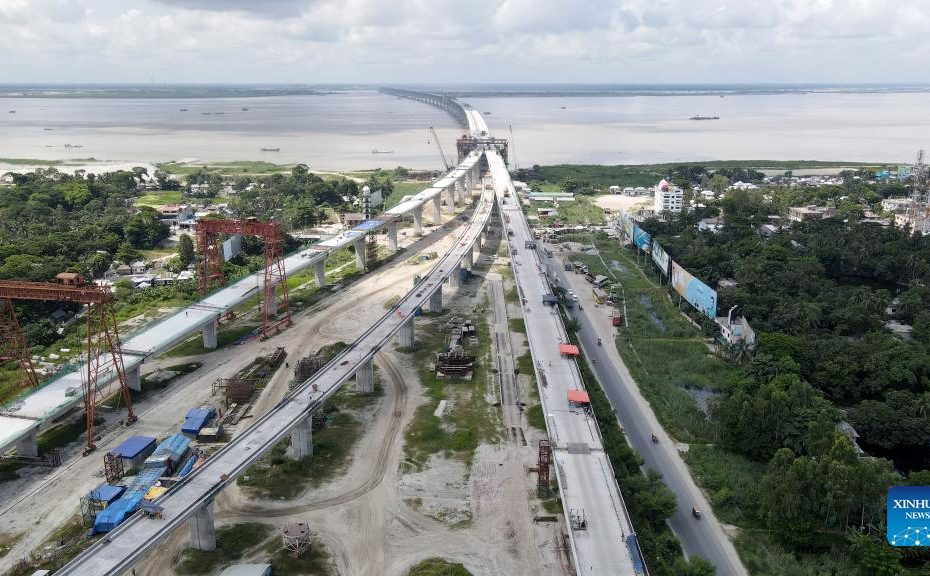DHAKA, Sept. 26 (Xinhua) — For Bangladeshis, a dream is coming true. The history of crossing the mighty Padma river between dozens of districts in southern Bangladesh and the capital of Dhaka only by ferries or boats is all set to end.
The mega multipurpose road-rail bridge dubbed the “Dream Padma Bridge” of Bangladesh is nearing completion after workers overcame tons of hurdles, including challenges brought by the COVID-19 pandemic.
The Padma Multipurpose Bridge Project is located at about 40 km southwest of Bangladesh.
The huge infrastructure, with the main bridge spanning 6.15 km in length, is undertaken by China Railway Major Bridge Engineering Group Co, Ltd (MBEC). It is the largest and most challenging infrastructure project in Bangladesh’s history.
The bridge, which crosses over the Padma river to link the northeast and southwest of Bangladesh, is also an important channel connecting the “Trans-Asian Railway.”
The construction of the Padma Multipurpose Bridge reached a milestone with the completion of road slab installation work last month, meaning the long wait for the bridge is now almost over.
Dewan Muhammad Abdul Kader, executive engineer of the project from the Bangladeshi government side, has told Xinhua how the Chinese engineers overcame the hurdles in building the bridge whose every pier and span presented numerous challenges to them.
Padma is the highest priority project funded by the Bangladeshi government, he said, adding that its construction started in December 2014.
“And our main contractor is MBEC, which is the best contractor of China,” he said.
In early March 2020 when Bangladesh suffered the COVID-19 blow, he said the Chinese and the Bangladeshi governments jointly took precautionary measures to ensure the project continued its work. Therefore, the bridge’s construction was not disrupted by the pandemic.
Pile-driving was a very complicated process in the mighty Padma river and they faced many difficulties, he said.
The main bridge has a total of 294 piles, of which 262 piles of 40 piers are in the main river and 32 piles of two transition piers on both sides.
“Out of these, 71 piles are skin grouted piles driven, and MBEC engaged high hammer, high technology and high-skilled labor to overcome these challenges,” Kader said.
“Other challenges are friction pendulum bearing and the installation of steel structure. With the imported 4,000 ton ‘Tianyi’ floating crane owned by the company, they have already overcome all the challenges,” said Kader, who is engaged in every aspect of the bridge’s construction matter since the beginning.
“Our project will be completed in June 2022 and our Prime Minister Sheikh Hasina will inaugurate this bridge, which offers an easy traffic option for locals to travel from Dhaka to southwest region of Bangladesh,” he said.
The bridge has provisions for rail, gas, electric line and fiber optic cable for future expansion. The Bangladesh Bridge Authority (BBA) is the executing agency of the project.
The double-layer steel truss bridge will carry a four-lane highway on the upper deck and a single-track railway on the lower deck.
Xiong Shikun, deputy project manager of the project from the MBEC, said they already completed all roadway slab erection by Aug. 23 this year, but there are still a lot of works remaining relating to the highway on the upper deck and the single track railway on the lower deck.
“We know Padma Bridge is a pride of Bangladesh. So our company (MBEC) and all of our engineers and staff members continued to work hard despite the COVID-19 pandemic,” he said.
“We’re trying our best to complete construction as earlier as possible,” he said. “I want to say thanks to my Chinese brothers and Bangladesh friends.”
For roadway, it’s expected that all remaining works will be completed by the end of June or beginning of July next year and then they can hand it over to the BBA, and that means Padma bridge is expected to be opened to traffic next July, he said.
“There is a good friendship between China and Bangladesh. I’ve already worked in Bangladesh for about 10 years, and I found it a friendly country. It’s our pleasure to implement more and more projects in Bangladesh.”
Mohammad Nayeem Hossain, a Bangladeshi official of the MBEC, said he is very happy to be engaged with the MBEC project team.
After overcoming many adversities, he said the dream Padma Bridge has nearly come true.
“I have been working with them for six years and I have learned a lot from them. I’m very happy,” he said.
“We’re working here as a family,” he further said.
Chinese people are here, far from their families, and they have made many sacrifices to make the dream Padma Bridge a reality, said the official.
“Their success means our success, and I’m personally very proud of them and their success in building this dream bridge,” he said. Enditem

